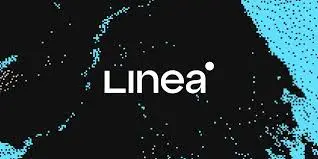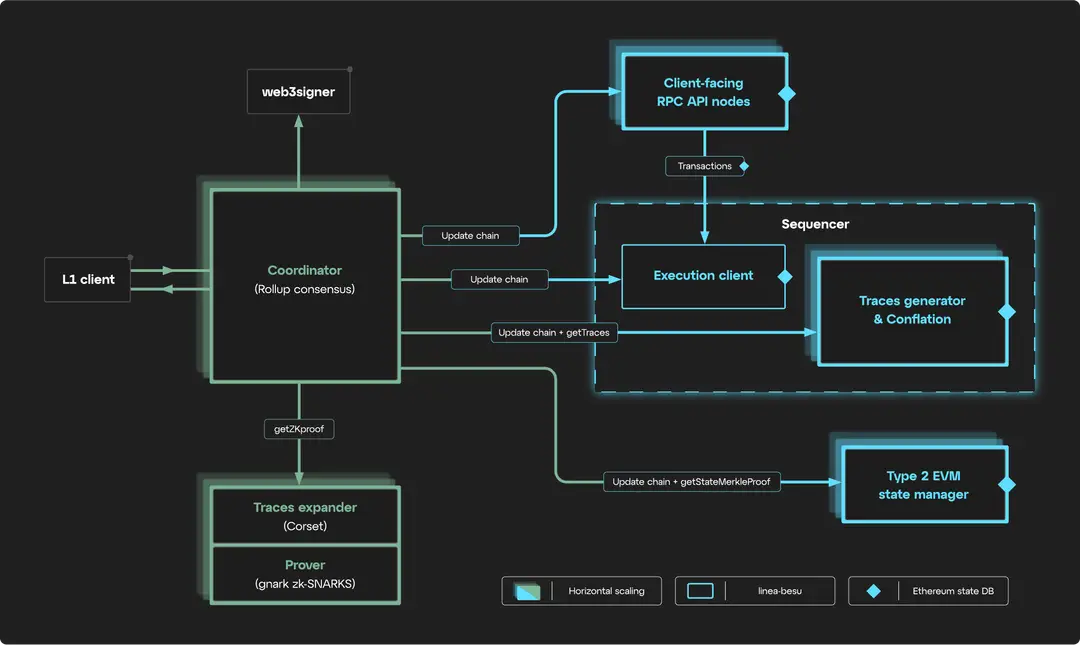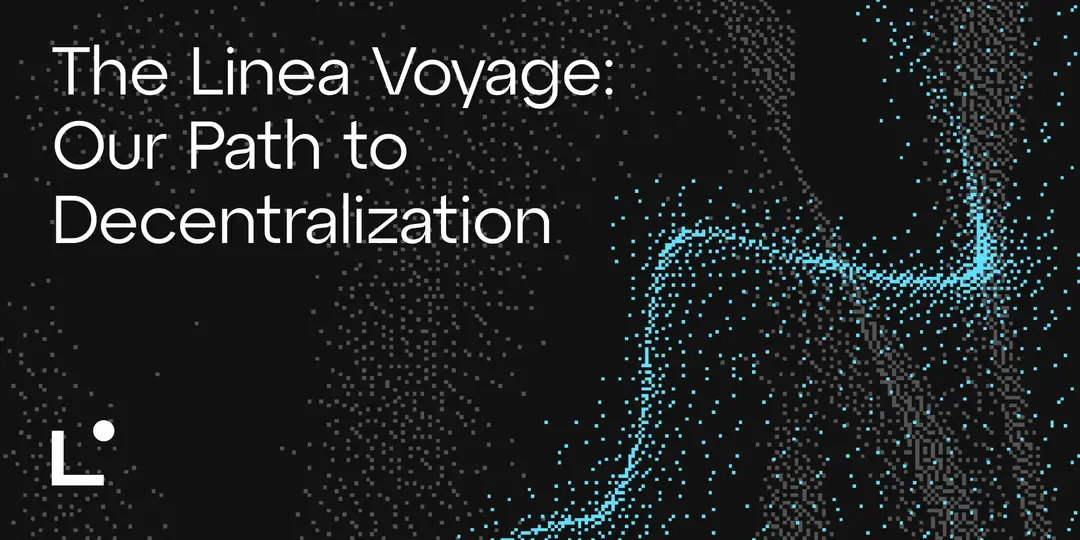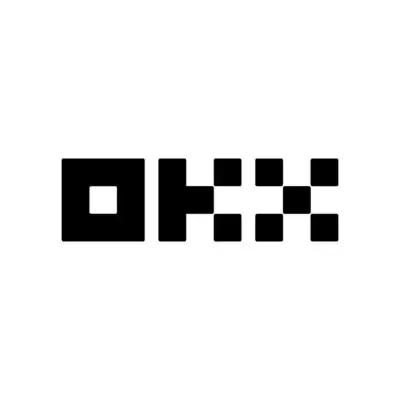Back
Linea
Linea
By HackQuest
May 30,20247 min readWelcome to the Web3 world, where digital finance and applications are shown in a revolutionary way through the fusion of blockchain technology, cryptocurrencies, and a pioneering spirit. Are you overwhelmed by the wealth of terms in the Web3 world that you don’t understand? Are those slangs barriers for you to learn about Web3? Don’t worry! We’re here to explain the obscure terms to guide your learning. Today, we're diving into an exciting development in the world of Web3: [Linea].
Overview
Linea Network stands out as a highly promising Layer-2 solution. Developed by Consensys, a Web3 software company established by Ethereum co-founder Joseph Lubin, Linea is a zkEVM layer-two chain. It utilizes zero-knowledge proofs to confirm transactions off-chain and then submits a cryptographic proof to the Ethereum mainnet, resulting in high transaction throughput and reduced gas costs.
Being compatible with the Ethereum Virtual Machine (EVM), Linea Network allows any smart contract or decentralized application (DApp) that operates on Ethereum to function seamlessly on its platform without needing any modifications. The network uses an innovative lattice-based prover to efficiently and securely generate zkSNARK (Zero-Knowledge Succinct Non-Interactive Arguments of Knowledge) proofs, which do not require a trusted setup.

Source: ODaily
How Does Linea Work?
Coordinator
The Coordinator is a crucial part of Linea’s structure, serving as a central hub that coordinates the network's operations. It oversees the flow of data among various components like the Sequencer, the EVM State Manager, the Prover, and the Verifier. Furthermore, it connects Linea with other blockchains, data solutions, and network nodes. Featuring a modular design, each component within the Coordinator operates independently yet communicates through this central system. The Coordinator's main responsibilities include managing network operations and maintaining both its security and efficiency.
Sequencer
At the heart of Linea's operational mechanism, the Sequencer is responsible for the order, assembly, and execution of blocks. It organizes transactions from Linea’s mempool into blocks in a specific sequence, then executes them using linea-geth, a tailored version of the Geth protocol optimized for zero-knowledge proofs. It also generates trace data crucial for creating proofs. By working closely with the Coordinator, the Sequencer ensures that blocks are optimized for proof generation and data availability, aided by systems like the Trace Generator and the Batch Conflator.
EVM State Manager
The EVM State Manager plays a vital role in managing Linea’s network by utilizing the Ethereum Virtual Machine (EVM) to execute smart contracts. It monitors and updates the global and account states based on trace data from block executions managed by the Sequencer. This updated state is crucial for the Prover to create and submit zero-knowledge proofs to the Ethereum blockchain.
Prover
The Prover is the component that generates zero-knowledge proofs for Linea’s transactions. It transforms trace data provided by the Coordinator into zk-SNARKs (zero-knowledge succinct non-interactive arguments of knowledge), using advanced lattice-based cryptography to avoid trusted setups and expedite the proof process. Additionally, it compresses the proofs with gnark, a library dedicated to efficient zk-SNARK creation and verification.
Verifier
Operating as a smart contract on the Ethereum mainnet, the Verifier checks the proofs submitted by the Prover. It connects Linea’s operations to the Ethereum network, using a public verification key to confirm the proofs and update Linea’s state on Ethereum. This includes reflecting the latest user and DApp data and balances and enabling fund transfers between Linea and Ethereum.
Network Data
This component ensures Linea’s blockchain is publicly accessible and responsive. It processes queries from users and DApps in line with Ethereum JSON-RPC API standards, including handling account information requests from MetaMask users on Linea. Network Data includes various specialized nodes, such as client-facing RPC-API nodes and archive nodes, supported by services like Infura and Consensys, to optimize network performance and availability.

Source: Linea Docs
Advantages
1.High transaction speed: Linea is capable of handling over 10,000 transactions per second, significantly outpacing Ethereum's capacity of 15 transactions per second.
2.Low gas fees: Linea cuts gas fees by up to 99%, making decentralized finance (DeFi) more affordable and accessible to a broader audience.
3.EVM compatibility: Linea supports smart contracts that are both compatible with zero-knowledge proofs and the Ethereum Virtual Machine (EVM), ensuring easy migration and interoperability of both existing and new decentralized applications (DApps).
4.Integration with MetaMask and numerous DApps: Linea is integrated with MetaMask, the leading web3 wallet used by over 10 million users monthly. Additionally, Linea supports over 100 DApps, spanning decentralized exchanges, lending protocols, perpetual contracts, and social finance platforms.
Linea DeFi Voyage
Linea DeFi Voyage is a six-week gamified experience designed by Linea to help users discover and learn about the ecosystem and its DeFi development services in an engaging and beneficial manner. The program was tailored to accommodate everyone from web3 newcomers to seasoned investors, offering straightforward guides and educational materials developed in collaboration with MetaMask Learn and Intract.
The Linea DeFi Voyage featured ten waves of quests and essential tasks. Each wave contained one mandatory core task that participants had to complete to progress to the subsequent wave. Additionally, users had the option to undertake bonus tasks to earn extra rewards. Each task varied in difficulty and offered different XP rewards. Participants could join the event at any stage, but they had to finish all the waves by the deadline to qualify for the ultimate prize. The final reward, the XP token, is anticipated to be exchangeable for Linea ecosystem's native token in the future.

Source: Linea Mirror
Wave 1: MetaMask
Voyagers began their Layer 2 DeFi journey by transferring funds into Linea and trading tokens on Velocore via MetaMask Portfolio, enhancing Ethereum scaling and maximizing LXP.
Wave 2: Bridging and Onramps
This phase allowed Voyagers to delve into Linea’s bridging ecosystem, exploring on-ramps that support fiat-to-crypto conversions and techniques that bridge Ethereum with other blockchains.
Wave 3: Token Swaps
Voyagers navigated Linea’s DEX and DEX aggregator ecosystem, learning about smart contracts, liquidity pools, and the risks of token swapping, along with different crypto assets like stablecoins and liquid staking tokens.
Wave 4: Lending and Borrowing
This wave took Voyagers through DeFi money markets, where they learned about decentralized versions of traditional financial tools like lending and borrowing, including the associated terms, risks, and benefits.
Wave 5: Liquidity Provision and Yield Farming
The complexity ramped up as Voyagers learned how to provide liquidity and engage in yield farming, understanding the risks involved in adding assets to decentralized exchanges.
Wave 6: Proof-of-Humanity
Voyagers confirmed their identities using Verax, an on-chain attestation system that builds a trust and reputation score from public data. This method goes beyond traditional trust sources, enhancing security by using reputation protocols with on-chain data.
Wave 7: Trading
Participants explored complex trading products within DeFi, learning how DeFi’s modular and stackable components offer a dynamic financial ecosystem that surpasses traditional financial products.
Wave 8: SocialFi
Focus shifted to decentralized social interactions in “SocialFi,” involving the creation of NFTs to document individual DeFi journeys and exploring the blend of social media and decentralized finance with platforms like Tomo.
Wave 9: SuperDApps
Voyagers explored advanced Web3 wallets, known as SuperDapps, which offer enhanced functionalities, robust security, and seamless user experiences, acting as powerful gateways to decentralized finance.
Wave 10: Account Abstraction
The final wave introduced Voyagers to account abstraction with Timeless Wallet, simplifying the user experience in web3 dApps by eliminating complex processes and reducing gas costs. This wave highlighted significant UX advancements, showcasing features like transaction sponsoring and paymasters within the Linea ecosystem.
In the News
Breaking News: OKX Adds Linea's FOXY to Its Perpetual Futures Market

Source: Yahoo Finance
OKX has officially announced the listing of FOXY on its perpetual futures market as of 8:30 AM (UTC) on April 12. This new listing allows traders to take long or short positions on FOXY with up to 50x leverage. Additionally, margin trading and the Simple Earn feature for the token will become available at 4:00 AM (UTC) on April 15. Further information about the FOXY perpetual futures contract can be found here.
FOXY is a memecoin supported by Linea, an innovative platform created by ConsenSys designed to address the scalability issues of Ethereum. ConsenSys aims to fully harness the capabilities of DApps by overcoming the constraints of the Ethereum mainnet through Linea. The platform is built on its zkEVM (Zero-Knowledge Ethereum Virtual Machine) rollup network, which integrates the efficiency of zero-knowledge proofs with the versatility of the Ethereum Virtual Machine, ensuring compatibility and high-performance operation akin to the EVM.
Conclusion
Linea aims to create a scalable and user-friendly platform that allows developers and users to effortlessly build and operate DApps on Ethereum, while also promoting a future fueled by clean, sustainable energy through web3. The platform has grand ambitions to support an increasing number of DApps and platforms, launch its own native token, and grow its community and ecosystem significantly.
Linea stands out as one of the most promising and dynamic L2 solutions in the web3 arena, offering substantial benefits to DeFi and web3 enthusiasts. If you are interested in learning more about Linea or other DeFi development solutions, Codezeros is here to assist. Contact our decentralized finance development company today to schedule a free initial consultation.